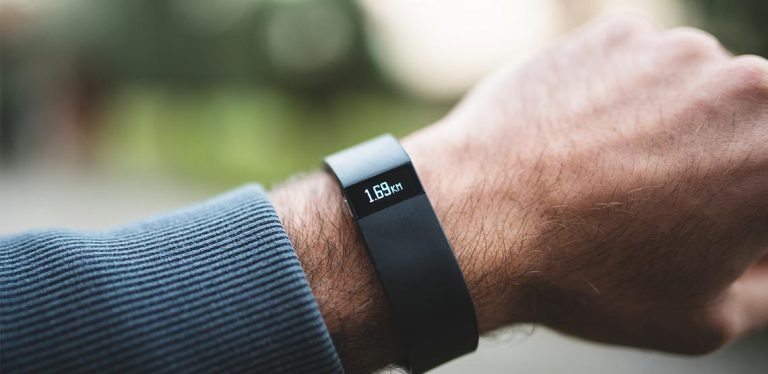Keep Yourself on Track
You’ve probably seen your favorite celebrity with one neatly wrapped around their wrist and wondered what it’s for. Fitbits are a type of wearable technology that can be used by everyone, from athletes to normal working people. A Fitbit is an activity tracker designed to help people keep fit by achieving their desired health and wellness levels.
It works like a pedometer only that it has many more exciting features.
Fitbits provide a medium of consistent encouragement and goal setting for a daily workout plan. It’ll constantly remind you to keep working, keeping your goals front of mind. Fitbit measures steps, tracks your heartbeat, and monitors sleep and calories burned throughout the day.
How It Works
Fitbit follows as sequential flow of Track, Sync, Progress, Achieve, and Inspire.
- Track: Involves tracking activity, exercise, food, weight, and sleep. It provides real-time information about your day and night.
- Sync: Use the app to synchronize your statistics wirelessly and automatically from your Fitbit device to your PC or Smartphone
- Progress: Use your phone or computer to monitor your progress. There are charts and graphs on the Fitbit dashboard that analyze the data from your daily activities and show your progress for the day.
- Achieve: Reach your goals by viewing your progress notifications. Get awarded for reaching your milestones with achievement badges.
- Inspire: Spread the word to friends and family to join your journey to achieving fitness with the leaderboard, social challenges, and cheers or boos.
Sensors and Algorithms
Fitbit uses sensors and inbuilt algorithms to calculate and generate your daily stats. Compared to other competitors, Fitbit is one of the most accurate in terms of measured steps and calories burned/energy expenditure. This is largely due to Fitbit’s algorithm, although the developers have yet to publicly reveal how they arrive at their metrics.
Fitbit’s algorithm calculates how many calories you burned during the day and night by measuring heart rate and perspiration rate. Fitbit has an mobile fitness app which sync data with Smartphones to track progress and help users set targets. The app is available on Android, iOS and Windows and comes complete with a community page for social interactions and setting challenges/targets.
Range of Fitbit Products
The Fitbit official website has over 17 products including wearables, but the most popular picks include: Zip, Flex2, Alta, AltaHR, Charge 2, Blaze, Ultra, and Iconic.
Pros of Fitbit Wearables
- Easy to Use: The setup is quite straightforward. Immediately start viewing stats on your heart rate, steps taken, quality of sleep and so much more.
- Easy Monitoring: Fitbit shows your fat burning zones and the amount of energy used during the day. Users can measure their progress using charts and graphs.
- Motivational Aspect: Fitbit wearables vibrate after reaching milestones, subconsciously increasing motivation levels for achieving your goals.
- Challenging: The Fitbit community page encourages engagement between friends, family or even total strangers. Users can set challenges and compete against each other or alternatively help each other reach their fitness goals.
Cons of Fitbit Wearables
- Privacy Issues Fitbit collects personal data and allows users to choose if this information can be made public or not. Some users are unaware of this fact and may have their personal activity (including sometimes sexual) information publicly displayed without their knowledge.
- Inaccuracy Issues: Fitbit sometimes does not get accurate step data on activities like riding bikes, running on a treadmill or pushing a heavy object.
You May Also Like:
Related Search Topics (Ads)
Factors to Consider When Choosing the Best Fitbit for You
- Data Demands When going through your fitness workout, ask yourself what kind of data you need to track. On average, Fitbit wearables measure steps taken and sleep patterns. Other Fitbit features include multi-sport tracking, PurePulse® heart rate, cardio fitness level tracking, a built-in GPS, a connected GPS, and call and text notifications.
- Screen Display: A band with a built-in display is convenient for tracking fitness goals as well as keeping an eye on the time without the need of using the native Fitbit app. The Fitbit Charge 2 has a great display and includes extra features such as a heart rate tracker and guided breathing.
- Durability/Battery: For any fitness tracker to be effective it needs to be robust to track your daily activities. Any flaw in software or hardware many result in damage to the device rendering it useless. Fitbit has durable wearables that can endure most workout exercises. Battery life is what separates durability; some devices like the Fitbit Ultra and Fitbit Zip can last up to seven days while Surge and Ionic last for two to three days.
- Waterproof: Swimming is a great workout. If hitting the pool in the evening is your preferred exercise then you need a waterproof device. The Fitbit Ionic is tough and works well for a range of fitness focused programs including swimming, weight lifting and activities that involve tackling. It is water resistant up to 50m. Fitbit Flex 2 was the first waterproof device from Fitbit but it comes with basic tracking ability.
- Design of the Wearable: Most of Fitbit’s products are worn around the wrist like a band or on your clothing using a clip. Fitbit wearables also come in a range of colors so you are able to accessorize the right one for your tastes.

